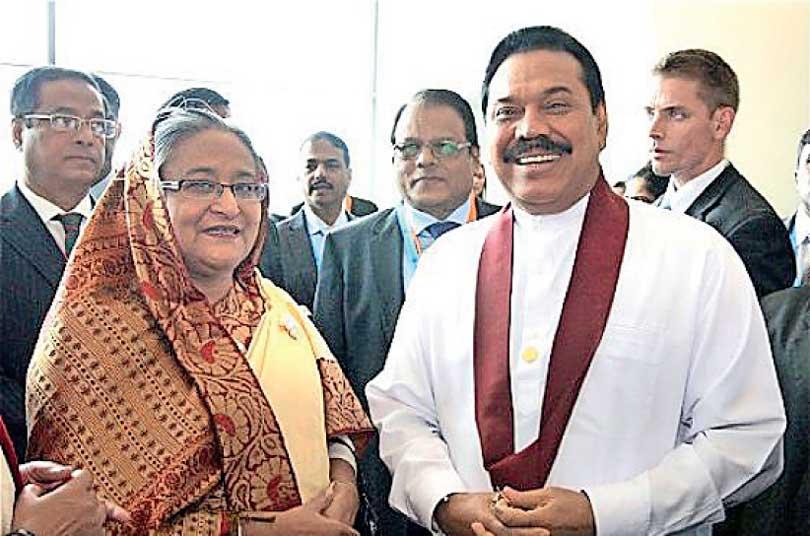Reply To:
Name - Reply Comment
Prime Minister Mahinda Rajapaksa will be visiting Bangladesh from tomorrow, Wednesday, March 17 to take part in Bangladesh’s Golden Jubilee celebrations. He is also expected to have meetings with Sheikh Hasina. What are the prospects for economic ties between Sri Lanka and Bangladesh?

Sheikh Hasina with Mahinda Rajapaksa

Colombo, March 15: The forthcoming visit of Sri Lankan Prime Minister Mahinda Rajapaksa to Bangladesh to participate in the grand celebrations connected with the 50th anniversary of Bangladesh’s independence, offers a golden opportunity to develop economic ties, an area crying for attention.
The Sri Lankan Prime Minister, who begins his visit on March 19, will be a Chief Guest and deliver an oration on one of the days during the festivities which are to be held between March 17 and 26.
The past, ancient as well recent, provides a strong foundation for good relations between the two countries. Sri Lanka and Bangladesh may differ in religion, but much of their culture is shared. Both Sinhala and Bengali are deeply rooted in Sanskrit.
 They even share a common ancestry because Prince Vijaya, the putative founder of the “Sinhala Race”, is said to have come from Bengal. Sri Lanka and Bangladesh both want to see South Asian unity forged through SAARC, which Bangladesh proposed and Sri Lanka has ardently supported since 1985.
They even share a common ancestry because Prince Vijaya, the putative founder of the “Sinhala Race”, is said to have come from Bengal. Sri Lanka and Bangladesh both want to see South Asian unity forged through SAARC, which Bangladesh proposed and Sri Lanka has ardently supported since 1985.
However, despite the commonalities and the signing of many MoUs, the level of economic relations, has been low. Bilateral trade is between US$ 150 million and US$ 180 million. One of the reasons for this is that connectivity is poor. People to people contact and awareness of opportunities are minimal. The Dhaka-Colombo-Dhaka airfare is US$ 973, way above affordability. Sri Lanka’s high tariffs are another block to trade.
There is no food shortage in Bangladesh. It is now the fourth-largest rice producer, the second-largest in jute producer, the fourth-largest in mango production, the fifth-largest in vegetable production and the fourth-largest in inland fisheries in the world
SL needs to use Bangladesh’s growth
Bangladesh’s phenomenal growth, especially since the advent of Sheikh Hasina as Prime Minister in 2008, should be a catalyst for economic engagement between Sri Lanka and Bangladesh.
Growing at 8.1%, Bangladesh is no longer a “basket case”. It is now a South Asian Tiger developing expertise in several sectors like agriculture, inland fisheries, pharmaceuticals, disaster prevention and disaster management.
There is no food shortage in Bangladesh. It is now the fourth-largest rice producer, the second-largest in jute producer, the fourth-largest in mango production, the fifth-largest in vegetable production and the fourth-largest in inland fisheries in the world.
With a good industrial climate, a friendly and development-oriented government and bureaucracy, and cheap labour (the cheapest in South Asia and 75% cheaper than in China), FDI is flowing into Bangladesh. China has pledged US$ 33 billion under its Belt and Road Initiative (BRI).
Bangladesh Prime Minister Sheikh Hasina told the World Economic Forum (WEF) in October 2019 thus:
“Today, Bangladesh offers the most liberal investment regime in South Asia – in terms of the legal protection of foreign investment, generous fiscal incentives, concessions on machinery imports, an unrestricted exit policy, full repatriation of dividends and capital on exit. We are establishing 100 Special Economic Zones with a one-stop service across Bangladesh. Twelve of the zones are already functioning. Two zones are reserved for Indian investors. A number of high-tech parks are also ready for technology and innovative enterprises.”
The Bangladesh pharmaceutical industry was valued at US$ 1.5 billion in 2013, but it jumped to US$ 10 billion in 2020. The Bangladesh government gives the highest priority to developing the energy sector by committing itself to provide uninterrupted power to local industry by 2021 Bangladesh is way ahead in the use of solar energy, with 5 million households already using solar power.
Despite the commonalities and the signing of many MoUs, the level of economic relations, has been low. Bilateral trade is between US$ 150 million and US$ 180 million. One of the reasons for this is that connectivity is poor
Bangladesh is quickly moving to a high-value, knowledge-intensive society. As Sheikh Hasina told the WEF: “Last year, Bangladesh exported 12 industrial robots to Korea. Four ships made in Bangladesh have come to India. Bangladesh also has 600,000 IT freelancers – the largest freelancing community. In transforming the country into a Digital Bangladesh since 2009, we have ensured 100% ICT access for people at the grassroots. As a result, Bangladesh has the fifth-largest internet user population in Asia-Pacific.”
There are 23,000 Multi-Media classrooms, and 150, 000 teachers are part of the Teachers’ Portal which has put across 80,000 contents to help teachers improve their teaching. The aim is to post 900,000 contents on line. E-payments through mobile phones is the order of the day even at the grassroots level.
Social engineering
Writing about the reasons for Bangladesh’s radical transformation, Cornel University economist Kaushik Basu said: “ Bangladesh’s economic transformation was driven in large part by social changes, starting with the empowerment of women. Bangladesh has made significant strides towards educating girls and giving women a greater voice, both in the household and the public sphere. These efforts have translated into improvements in children’s health and education, such that Bangladeshis’ average life expectancy is now 72 years, compared to 68 years for Indians and 66 years for Pakistanis.”
“Among Bangladeshi adults with bank accounts, 34.1 per cent made digital transactions in 2017, compared to an average rate of 27.8 per cent for South Asia.”
Bangladesh’s labour regime is conducive to development, Basu says. “Having been born without the law, Bangladesh offered a better environment for manufacturing firms to achieve economies of scale and create a large number of jobs. And though Bangladesh still needs much stronger regulation to protect workers from occupational hazards, the absence of a law that explicitly curtails labour-market flexibility has been a boon for job creation and manufacturing.”
Bangladesh’s phenomenal growth, especially since the advent of Sheikh Hasina as Prime Minister in 2008, should be a catalyst for economic engagement between Sri Lanka and Bangladesh
Areas of Cooperation
With Bangladesh’s expertise, Sri Lanka can stop importing food items. Food imports accounted for 7.2% of Sri Lanka’s total imports in 2018. Unlike Sri Lanka, Bangladesh has reached self-sufficiency in food, including rice, having increased food production from 10 million tons in 1972-73 to 39 million tons in 2015/16. Like Sri Lanka, Bangladesh experiences droughts and floods frequently. But Bangladesh has found ways to overcome the challenges through “climate adaptation techniques.”
Bangladeshi farmers in flood-prone areas are using a variety of rice that can remain submerged for seven days without getting damaged. They also use rice varieties that can withstand drought and salinity. In tackling drought, Bangladesh has been able to reduce the use of water in rice cultivation by half – from 3500 litres per kg of rice to 1800 litres. This technique can be used in the arid zones of Sri Lanka.
Sri Lanka can economize on its fish imports by encouraging inland fisheries with Bangladesh’s help. According to the statistics of the Fisheries Department, the quantity imported from 2018 has been 84,463 metric tons spending LKR 32,726 million. There is vast scope for developing inland sweet water fisheries in Sri Lanka with Bangladesh’s help as there are many tanks on the island.
On its part, Sri Lanka can help the hotel and hospitality sector in Bangladesh grow as it has a longer tradition in these fields. It could help organize the Bangladesh tourism sector which is still in its infancy.
Investment
Bangladesh has opened its doors wide to Sri Lankan investors. Sri Lanka’s total investment in Bangladesh stands at about US$348 million. Around 30,000 Sri Lankan professionals are working in the Bangladesh garments, power and logistics sectors.
Some Bangladeshi companies have established a foothold in Sri Lanka but in a much smaller way. Sri Lanka should emulate Bangladesh and be more welcoming to investors from there.
It is hoped that the Sri Lankan Prime Minister’s visit to Bangladesh will translate into greater economic cooperation touching people’s lives. Needless to say, Sri Lanka has much to gain by becoming part of Bangladesh’s phenomenal growth story.